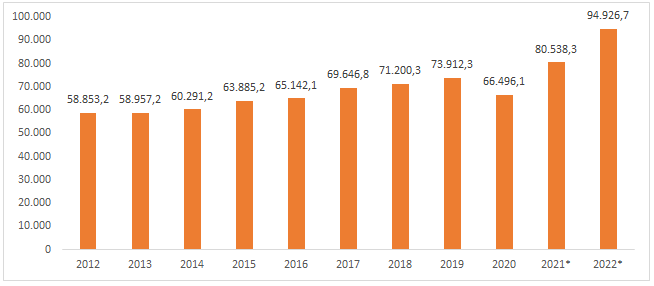- According to ACCIÓ’s calculations, this is the best figure since official records began and a result that highlights the strength of the foreign activity of Catalan companies despite today’s difficult international situation
- The Minister for Business and Labour, Roger Torrent i Ramió, confirmed that “the Catalan export sector is growing despite the challenges of a complex global context, which is great news from the point of view of the country’s economic structure and the potential for the coming years”
- The number of Catalan companies registered as regular exporters in 2022 stood at 17,469, the highest figure since records began and 2.2% more than the previous year
Catalan exports grew by 17.9% in 2022, totalling 94.927 billion euros, the highest figure since records began according to calculations by ACCIÓ – the Ministry of Business and Labour’s agency for business competitiveness – based on the data published today by the Spanish Ministry of Industry, Trade and Tourism.

As a result, of all the autonomous communities, Catalonia is the highest contributor to Spain’s exports, accounting for 24.4% of the total. The number of Catalan companies registered as regular exporters in 2022 stood at 17,469, the highest figure since records began and 2.2% more than the previous year.
According to the Minister for Business and Labour, Roger Torrent i Ramió, “the Catalan export sector is growing despite the obvious challenges of a very complex global context. This makes us more resilient and optimistic about the future”. Minister Torrent continued, “We achieved the highest figure since records began in terms of foreign sales and we also increased the number of exporting companies: this is great news from the point of view of the country’s economic structure and the potential for the coming years”. He declared that “we continue to work during 2023 to continue to bolster these figures, both from within ACCIÓ and in collaboration with all the stakeholders involved in the internationalisation of our country”.
Indeed, the growth of exports in Catalonia during 2022 was higher than that of global foreign trade as a whole, which the World Trade Organization (WTO) places at 3.5%.
By sector, the growth in Catalonia’s foreign sales was most notable in chemical products (+19.8%), food and beverages (+15.2%) and capital goods (+12.5%). Exports in 2022 were mainly to France (with a year-on-year growth of 26.8%), Germany (16.4%), Italy (16.2%), Portugal (20.6%), Switzerland (18%), the United Kingdom (5.1%) and the United States (20.7%).
By province, Catalonia’s sales abroad show an increase throughout the region: Girona (just shy of 7.788 billion euros, up 21.2%), Barcelona (73.751 billion euros, up 19.6%), Lleida (2.901 billion euros, up 15.6%) and Tarragona (10.487, up 5.4%).
Taking a longer period as reference, in the last 10 years Catalan exports have grown uninterruptedly, with the only exception being 2020 due to the lockdown caused by the pandemic. In all, during the last decade, Catalonia’s sales abroad have increased by 61.3%.
Risks for 2023
Next year, Catalan companies will have to deal with a set of international risks that may affect their activity abroad. According to a study by ACCIÓ, threats include the weaponisation of world trade, digital decoupling between regions, the technological deficit of the EU, greenflation and also the danger of stagflation. These risks – which can be consulted at this link – exist within a context of regionalisation of global value chains, polarisation between world regions, the climate emergency and the war in Ukraine.